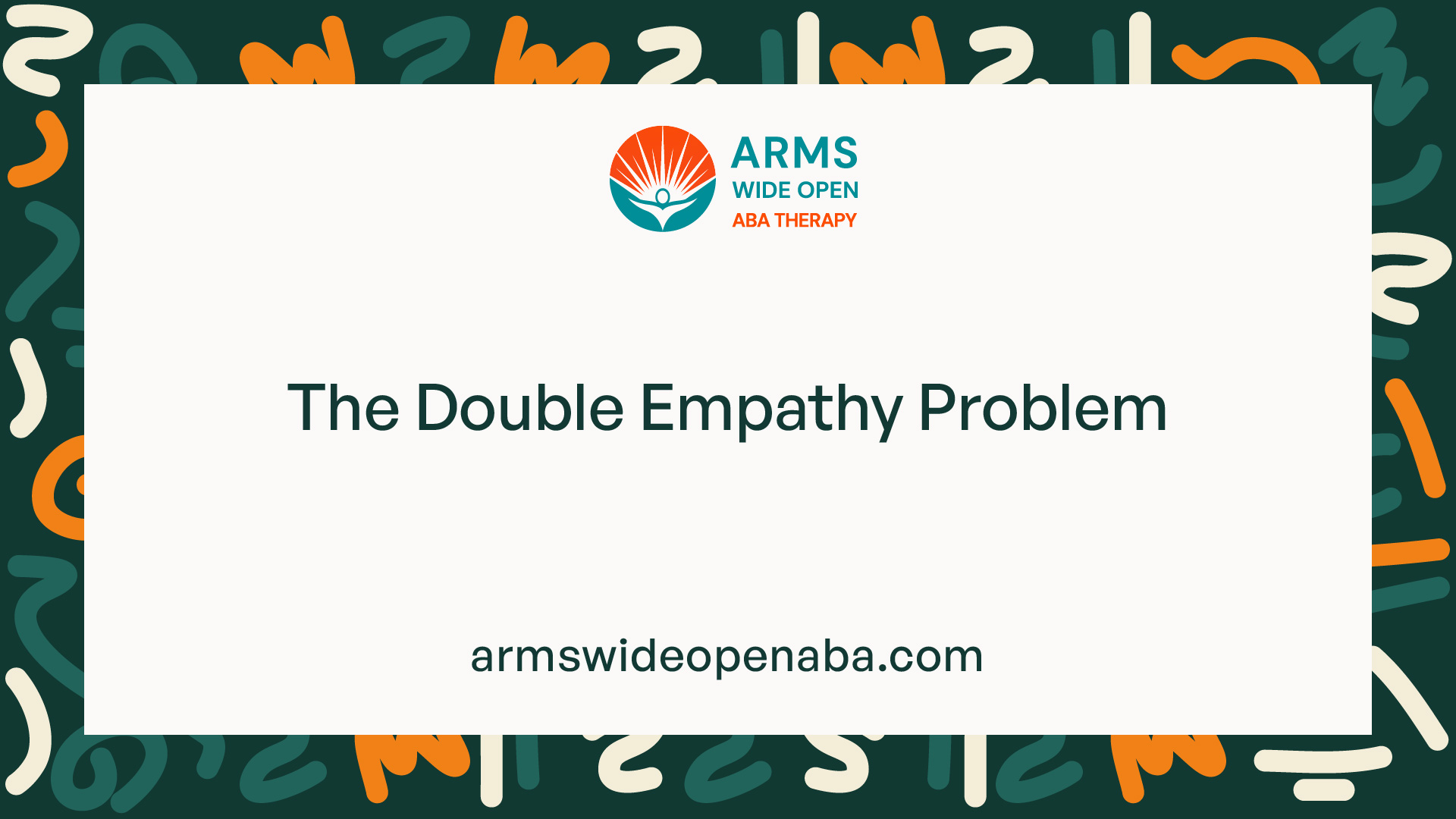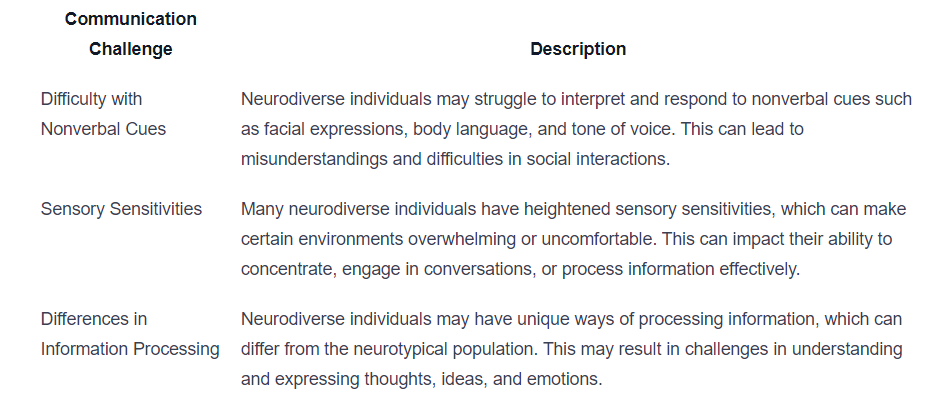The Double Empathy Problem
Uncover the barriers of the double empathy problem and learn how to bridge the communication gap for better understanding.

Understanding Empathy
Empathy is a fundamental aspect of human interaction and plays a crucial role in effective communication. Let's explore the definition of empathy and understand its importance in fostering meaningful connections.

Definition of Empathy
Empathy can be defined as the ability to understand and share the feelings, thoughts, and experiences of another person. It involves putting oneself in someone else's shoes and trying to grasp their emotions and perspectives. Empathy goes beyond sympathy, which is simply acknowledging and feeling sorry for someone's situation. Instead, empathy requires actively connecting with others on an emotional level and showing genuine understanding and compassion.
Importance of Empathy in Communication
Empathy is an essential component of successful communication. When we empathize with others, we create an environment of trust, respect, and understanding. Here are a few reasons why empathy is crucial in effective communication:
- Enhances Connection: By demonstrating empathy, we show others that we value their emotions and experiences. This fosters a sense of connection and builds stronger relationships.
- Improves Listening: Empathy encourages active listening, allowing us to fully comprehend what others are saying. By understanding their perspective, we can respond appropriately and effectively.
- Promotes Collaboration: Empathy helps to bridge different viewpoints and promotes collaboration. It allows us to appreciate diverse perspectives, leading to better problem-solving and decision-making.
- Reduces Conflict: Empathy plays a vital role in conflict resolution. When we genuinely understand and empathize with others, we can find common ground and work towards resolving conflicts peacefully.
- Supports Emotional Well-being: Showing empathy can have a positive impact on the emotional well-being of both the giver and receiver. It creates a safe space for individuals to express themselves and feel validated.
In summary, empathy is an essential skill that enables us to connect with others on a deeper level. By understanding and sharing in their experiences, we can foster effective communication and build stronger relationships.
The Double Empathy Problem
Understanding the concept of the double empathy problem is crucial for promoting empathy and effective communication. This section will define the double empathy problem and explore its impact on relationships.
Definition of the Double Empathy Problem
The double empathy problem refers to the mutual communication difficulties that arise when individuals with different cognitive profiles attempt to interact. It challenges the traditional assumption that communication difficulties solely lie with individuals who are neurodivergent or on the autism spectrum.
In the context of the double empathy problem, it is recognized that both neurodivergent and neurotypical individuals may struggle to understand and empathize with each other's perspectives. It highlights the need for a balanced approach to communication, where both parties make an effort to bridge the empathy gap.
How the Double Empathy Problem Affects Relationships
The double empathy problem can have a significant impact on relationships, leading to misunderstandings, frustration, and a breakdown in communication. Here are a few ways in which the double empathy problem affects relationships:
- Differences in Communication Styles: Neurodivergent individuals often have unique communication styles that may differ from mainstream societal norms. This can lead to misinterpretations and difficulties in understanding their intentions or emotions.
- Sensory Sensitivities: Individuals on the autism spectrum or with other neurodivergent conditions may experience sensory sensitivities that can affect their ability to process and respond to social cues. This can create challenges in effectively communicating their thoughts and feelings.
- Theory of Mind Differences: Theory of mind refers to the ability to understand that others have different thoughts, beliefs, and perspectives. Individuals with the double empathy problem may struggle to grasp each other's perspectives, resulting in misunderstandings and miscommunication.
- Social Context Challenges: Neurodivergent individuals may face challenges in navigating complex social contexts, including nonverbal cues, sarcasm, or subtle social norms. This can lead to difficulties in connecting with others and may strain relationships.
Recognizing and understanding the double empathy problem is the first step towards improving communication and fostering empathy between neurodivergent and neurotypical individuals. By acknowledging the unique perspectives and challenges faced by both parties, it becomes possible to bridge the empathy gap and build stronger, more inclusive relationships.
Neurodiversity and Communication: Bridging the Gap
Understanding the concept of neurodiversity is essential in addressing the challenges faced in communication, particularly regarding the double empathy problem. Neurodiversity refers to the natural variation in human brain function and behavioral traits, recognizing that conditions such as autism, ADHD, and dyslexia are not deficits but rather differences in cognitive processing and perception.
The double empathy problem, a term coined by autistic researcher Damian Milton, highlights the mutual misunderstanding that often occurs between neurodivergent and neurotypical individuals. This problem arises from differences in communication styles, social expectations, and ways of processing information, leading to a breakdown in mutual understanding and empathy.
To bridge this gap, it is crucial to foster a deeper understanding of neurodiversity and promote inclusive communication practices. This involves recognizing and respecting the unique strengths and challenges of neurodivergent individuals, as well as adapting communication strategies to accommodate different processing styles and sensory needs.
By embracing neurodiversity and actively working to overcome the double empathy problem, we can create a more inclusive and understanding society where effective communication is possible across the neurological spectrum. This requires a willingness to learn, adapt, and appreciate the diverse ways in which individuals perceive and interact with the world around them.
For more information on neurodiversity and the double empathy problem, check out the following resources:
Exploring Neurodiversity
Neurodiversity recognizes and celebrates the natural variations in the human brain. It emphasizes that neurological differences, such as autism, ADHD, and other conditions, are simply variations of the human experience rather than deficits. Each individual possesses unique strengths, perspectives, and ways of processing information.
Embracing neurodiversity promotes inclusivity and acceptance, encouraging society to value the diverse ways in which individuals communicate and interact with the world. By recognizing and appreciating these differences, we can foster a more inclusive environment for everyone.
Challenges Faced in Communication
Communication challenges arise when neurodiverse individuals interact with neurotypical individuals, as well as within neurodiverse communities themselves. These challenges can stem from differences in social cues and nonverbal communication, sensory sensitivities, and information processing.
To illustrate the challenges faced in communication, consider the following examples:

It is important to approach communication with empathy, patience, and understanding. By recognizing and accommodating these challenges, we can create an environment that supports effective communication between neurodiverse and neurotypical individuals, fostering mutual understanding and connection.
Breaking Barriers Through Awareness
In order to address the double empathy problem and improve communication between neurodiverse individuals and neurotypical individuals, it is essential to recognize and address misunderstandings that may arise.
Recognizing and Addressing Misunderstandings
Misunderstandings can occur when there is a lack of awareness and understanding of each other's perspectives. It is important to acknowledge that both neurodiverse and neurotypical individuals have different ways of perceiving and experiencing the world. By recognizing these differences, we can foster a more inclusive and empathetic environment.
To address misunderstandings, active listening plays a crucial role. Actively listening involves giving full attention to the speaker, trying to understand their perspective, and asking clarifying questions when needed. This helps to ensure that both parties are on the same page and reduces the likelihood of misinterpretations.
Another strategy is to promote open and honest communication. Encouraging individuals to express their thoughts and feelings in a respectful manner creates a safe space for dialogue and understanding. By actively seeking to understand each other's viewpoints, we can bridge the gap and break down barriers.
Strategies for Improving Communication
Improving communication requires a collaborative effort from both neurodiverse and neurotypical individuals. Here are some strategies that can be effective in fostering better understanding:
- Visual aids and written communication: Utilizing visual aids, such as diagrams or charts, can help convey information more clearly. Additionally, written communication, such as emails or text messages, allows for extra time to process and understand the message.
- Sensory considerations: Sensory sensitivities can impact communication for individuals on the autism spectrum or with sensory processing disorders. Being aware of and accommodating sensory needs, such as providing a quiet space or minimizing bright lights, can create a more comfortable environment for effective communication.
- Using clear and concise language: Keeping communication simple and straightforward can enhance understanding. Avoiding jargon or complex language helps to ensure that the message is conveyed clearly to all parties involved.
- Empathy and perspective-taking: Practicing empathy involves putting oneself in the other person's shoes and trying to understand their emotions and experiences. This can be achieved through active listening, asking questions, and being open-minded. Perspective-taking helps to build connections and foster empathy, ultimately improving communication.
By recognizing and addressing misunderstandings and implementing effective communication strategies, we can work towards breaking down barriers and creating a more inclusive society. It is through empathy, understanding, and a willingness to learn from one another that we can bridge the gap and forge meaningful connections.
Bridging the Gap
To overcome the challenges posed by the double empathy problem, it is crucial to focus on building empathy and understanding between individuals. This problem, which arises when people with different communication styles and ways of processing information interact, can lead to misunderstandings and difficulties in forming meaningful connections. However, by fostering a culture of empathy and actively working to bridge the gap, we can create an environment where everyone feels heard, respected, and valued. Here are two important strategies that can help in this process: building empathy and understanding, and the importance of active listening and perspective-taking.
Building Empathy and Understanding
Building empathy and understanding involves actively seeking to comprehend and appreciate the experiences and perspectives of others. It requires a willingness to step outside of one's own comfort zone and engage with individuals who may think and communicate differently. This can be achieved through various methods, such as:
- Educating oneself: Taking the initiative to learn about different neurodiverse conditions and the challenges faced by individuals with those conditions can help in developing empathy. It is important to educate oneself about the experiences, strengths, and limitations of individuals who think and process information differently. This can involve reading books, articles, and personal accounts, attending workshops or seminars, and engaging in conversations with neurodiverse individuals and their allies.
- Promoting open dialogue: Encouraging open and honest conversations can create a safe space for individuals to share their experiences and perspectives. By actively listening and engaging in respectful discussions, bridges can be built between different communication styles. This can be done in various settings, such as in the workplace, educational institutions, and social gatherings. It is important to create an environment where everyone feels comfortable expressing themselves and where differences are celebrated rather than stigmatized.
- Recognizing individual strengths: Acknowledging and valuing the unique strengths and abilities of individuals with neurodiverse conditions can foster empathy and understanding. Each person has their own set of skills and talents, and recognizing and appreciating these can help in breaking down barriers. This can involve highlighting the contributions of neurodiverse individuals in various fields, such as the arts, sciences, and technology, and creating opportunities for them to showcase their abilities.
Importance of Active Listening and Perspective-Taking
Active listening and perspective-taking are essential components of effective communication. They involve fully engaging with the person speaking, seeking to understand their point of view, and responding in a way that validates their experiences. By actively listening to others and trying to see things from their point of view, individuals can develop a deeper understanding of their experiences. Here are some key aspects to consider:
- Giving undivided attention: Actively listening involves giving one's full attention to the speaker. This means avoiding distractions, maintaining eye contact, and being fully present in the conversation. It also involves putting aside one's own thoughts and opinions temporarily and focusing solely on understanding the other person's perspective. This can be challenging, especially when the topic is emotionally charged or when there are disagreements, but it is essential for building trust and fostering meaningful communication.
- Empathetic responses: Responding with empathy and understanding can help validate the feelings and experiences of others. This can be done by expressing empathy, using reflective listening techniques, and asking open-ended questions to encourage further discussion. For example, instead of immediately offering advice or solutions, one can say something like, "That sounds really challenging. Can you tell me more about how that makes you feel?" This shows that you are interested in understanding their perspective and that you care about their experiences.
- Putting oneself in others' shoes: Perspective-taking is the act of trying to understand how others perceive and experience the world. By putting oneself in the shoes of someone with a different communication style, individuals can gain insights into their unique challenges and experiences. This can involve asking questions, seeking clarification, and trying to imagine how certain situations might feel for the other person. It also involves being open to the idea that one's own perspective may not be the only valid one and that there may be multiple ways of interpreting and experiencing the same situation.
By actively employing these strategies, individuals can bridge the gap created by the double empathy problem. Building empathy and understanding, along with practicing active listening and perspective-taking, can lead to more meaningful and effective communication, ultimately fostering stronger relationships and breaking down barriers. It is important to remember that this is an ongoing process that requires patience, commitment, and a willingness to learn and grow. By creating a culture of empathy and understanding, we can create a more inclusive and supportive society where everyone feels valued and respected, regardless of their differences.
Sources
https://www.crossrivertherapy.com/autism/double-empathy-problem
https://www.spectrumnews.org/news/double-empathy-explained/
https://www.autism.org.uk/advice-and-guidance/professional-practice/double-empathy
Similar articles
We’re here to help you

Our team is here to assist you in this process. Contact us for any assistance.
it’s easy to apply
We Accept Most Insurances
Our in-network insurance partnerships make ABA therapy more accessible to families throughout our service areas.







Our Insurance Process
We'll request your insurance details to help us verify your plan's coverage for ABA therapy. Once we've received this information, we'll walk you through your benefits, including copayments, deductibles and out-of-pocket maximums, so you know what to expect in advance.
Our team will then handle the preauthorization and all the necessary paperwork.
.svg)





















.jpeg)


































.jpeg)




.jpeg)







.jpeg)











.jpeg)
















